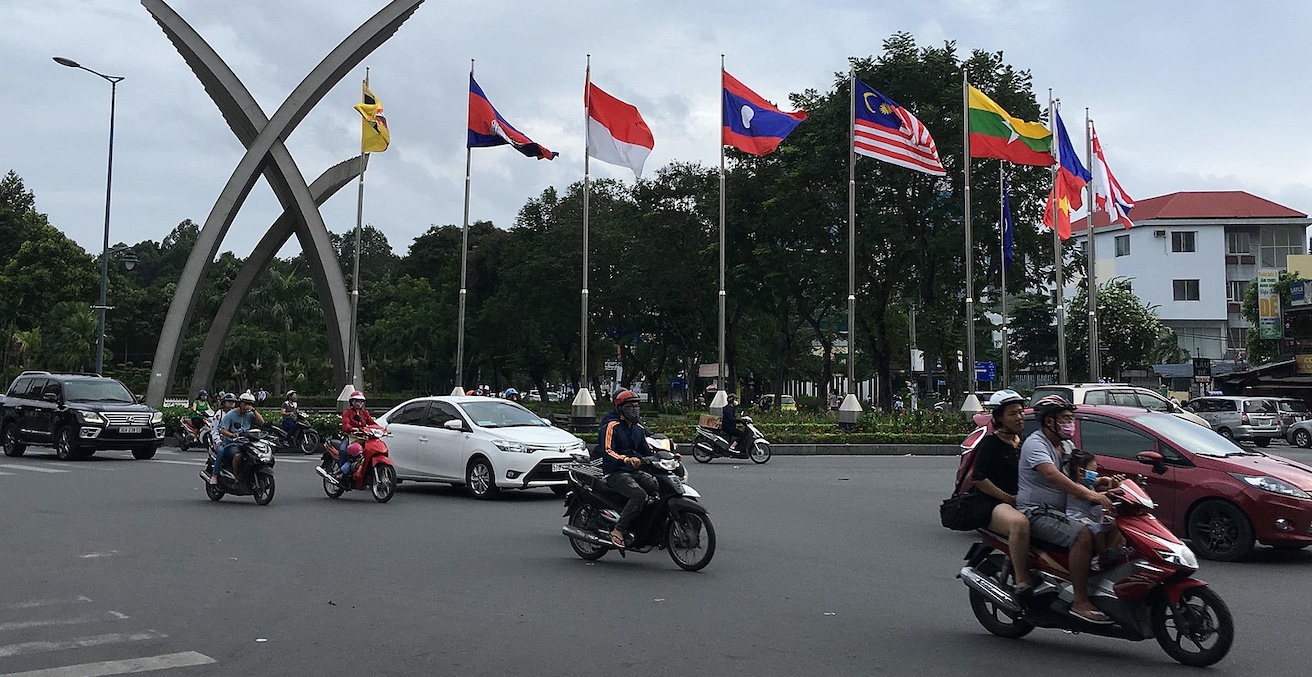Rethinking East Asian Peace, Over-deterrence, and Minilateralism

Asia’s exceptional peace owes much to its unique, dual security structure: deterrence-based military alliances and trust-building, inclusive multilateralism. But intensifying US-China rivalry now threatens to unravel it, driving over-deterrence and a surge in exclusive security minilaterals.
Amid the ongoing war in Ukraine and the humanitarian crisis in Gaza, East Asia—including, more broadly, Southeast Asia—has emerged as a notable exception, maintaining relative peace and stability. Despite longstanding tensions surrounding Taiwan, the Korean Peninsula, and maritime disputes in the East China Sea and the South China Sea, the region has avoided major war since 1979. What explains this exceptional peace? And with US-China competition intensifying, will it last?
Scholars have attributed East Asia’s stability to several factors: US hegemony and the hub-and-spokes alliance system, the region’s economic interdependence and growth-focused “developmental peace,” and cultural norms emphasising Asian values and harmony. Each explanation reveals some elements of truth. However, these accounts often overlook a key factor: Asia’s unique security architecture, which balances hard deterrence with inclusive, trust-building multilateralism.
Yet this unique security architecture is under strain. As the United States and China ramp up military posturing and forge exclusive security groupings, the region risks drifting toward over-deterrence and security fragmentation. To sustain peace, both countries must show strategic restraint, limit the expansion of minilateral security blocs, and revitalise inclusive multilateral institutions.
Exceptional peace in the region
By historical standards, East Asia is remarkably peaceful. From 1946 to 1979, it accounted for 80 percent of the world’s battle deaths. Since then, despite flare-ups and crises, no major interstate war has erupted. That track record outshines Europe, the Middle East, and South Asia.
Some credit the US alliance system for this peace. Others point to deepening trade ties and shared interests in economic development. Cultural arguments emphasise Asian traditions of consensus-building, Confucian ethics, or moderate religious practices. But these narratives have limits. The same US hegemonic order that supposedly ensures peace in Asia has not prevented wars in Europe or the Middle East. Trade ties did not stop tensions among states during the Asian financial crisis or the US-China trade war. Cultural unity is also complicated by Asia’s vast diversity.
Instead, Asia’s post-Cold War security architecture deserves closer attention. It comprises two layers. The first includes US bilateral alliances and UN-based collective security mechanisms, which deter aggression and provide a hard balancing function. The second layer features inclusive multilateral forums—such as the ASEAN Regional Forum, the Council for Security Cooperation in the Asia Pacific (CSCAP), and the Shangri-La Dialogue—that foster transparency and build trust among nations.
This dual-layer security architecture has served Asia well, deterring outright conflict while keeping diplomatic channels open. But it’s now being tested by new geopolitical dynamics.
The risks of over-deterrence
Taiwan has emerged as the “most dangerous place on earth.” Both the United States and China accuse each other of disrupting the status quo. Washington deepens ties with Taipei through arms sales and high-level visits. Beijing responds with military exercises and diplomatic freeze-outs. The cycle escalates.
Over-deterrence is a real danger. Rather than stabilising the region, excessive deterrence can provoke countermeasures, fueling arms races and heightening the risk of miscalculation. China’s increasing defence budgets and growing military assertiveness—such as dropping the phrase “peaceful reunification” from official rhetoric—signal its hardening stance. Meanwhile, US support for Taiwan continues to intensify, even as doubts remain about whether Washington would intervene militarily in a cross-strait conflict.
Taiwan is not Ukraine, and China is not Russia. Unlike NATO, Asia lacks a unified military alliance. These distinctions matter. Misreading them could lead to strategic blunders on both sides. Both the United States alone and its efforts to construct an Asian NATO may not strengthen deterrence capabilities against China. Instead, heightened deterrence measures by the United States may provoke China further, leading to an escalation in China’s deterrence capabilities and thereby undermining the original goal of US deterrence.
Minilaterals on the rise
Amid rising distrust, the region has witnessed a proliferation of US-led minilateral security groupings. The Quad, AUKUS, the US-Japan-Korea trilateral, and the US-Japan-Philippines summit are part of a growing “security latticework.” These minilaterals link America’s allies together, reinforcing deterrence against China.
But while they may address the threat of power grabs, they do little to resolve the region’s deepening trust deficit. Unlike ASEAN-centered multilateralism, which includes China and aims to socialise China’s behavior through norms and dialogue, these minilaterals exclude Beijing—and Beijing has noticed. Chinese officials dismiss the Quad as “sea foam” and warn that AUKUS is leading the region down a “path of error and danger.”
To China, these exclusive groupings represent institutional balancing strategies designed to constrain its rise. The United States and its partners view them as necessary hedges against China’s assertiveness. Both views contain truth—but they also create a self-reinforcing spiral of suspicion.
Inclusive or Exclusive?
Institutional balancing comes in two forms. Inclusive balancing brings rivals into institutions and uses norms to shape their behavior. Exclusive balancing forms institutions that intentionally leave rivals out, limiting their influence. ASEAN and the ARF are examples of the former. The Quad and AUKUS represent the latter.
Minilaterals can be efficient. It’s easier to reach a consensus among a few like-minded states. However, they come with costs: increased polarisation, heightened security competition, and the erosion of the region’s inclusive security architecture. Middle powers like South Korea, Australia, and the Philippines now face a dilemma. Should they prioritise deterrence by joining exclusive blocs, or maintain space for engagement by supporting inclusive forums? Their choices will shape the future regional order to some extent.
Strategic restraint and multilateral revival
Preserving East Asia’s peace will require deliberate efforts to recalibrate regional security. First, the United States and China must exercise strategic restraint. Washington should limit high-profile arms sales and visits to Taiwan. Beijing should reduce military exercises and signal a commitment to peaceful reunification. Mutual reassurance measures are essential to alleviate tensions between the two.
Second, both powers should revive multilateralism. The United States can reinvest in ASEAN-centered forums such as the East Asia Summit and the ARF. China should return to meaningful negotiations regarding a “code of conduct” in the South China Sea. ASEAN, in turn, must step up as a convener and confidence-builder.
Ultimately, all parties must steer clear of transforming the Indo-Pacific into an ideological battleground. Narratives of democracy versus autocracy may resonate well domestically, but they alienate important regional players and obscure practical interests.
East Asia’s peace has never been inevitable. It is the product of careful architecture, restrained behavior, and institutional engagement. As great power competition heats up, maintaining that peace will require more—not less—commitment to strategic balance and inclusive cooperation.
Kai He is Professor of International Relations at the School of Government and International Relations, Griffith University, Australia. This commentary is based on the following article: Kai He (2025). Rethinking East Asian peace: the perils of over-deterrence and minilateralism. Australian Journal of International Affairs, 79(2), 295–305. Access the article here.
This article is published under a Creative Commons License and may be republished with attribution.





